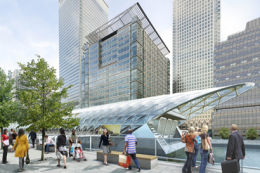Posted 28th September 2010 | 2 Comments
Crossrail tunnelling to start next year

Canary Wharf Crossrail station
CROSSRAIL has announced that the scheme is set to survive the government's spending cuts, and the company has also undertaken not to reduce the length of the route or the number of stations.
Boring of tunnels under central London is expected to start in 2011.
However, innovative rolling stock is not part of the vision: to keep costs as low as possible, Crossrail trains will be based on ‘tried and tested designs’.
Network Rail has announced that it has submitted the estimated costs for upgrading the existing surface infrastructure. These costs for surface works will be a vital component of Crossrail’s updated estimates of the total investment needed.
The chairman of Crossrail, Terry Morgan, said: “Crossrail and its delivery partners recognise fully that Crossrail is a significant investment. It is critical that every pound invested in this vital scheme achieves maximum value for money. Sensible efficiency savings will be made at every opportunity.
"Crossrail is bearing down on its whole cost base, while ensuring delivery of a new railway that is fit for purpose and delivers the capacity improvements required. We are looking at every aspect of Crossrail to identify where efficiencies can be made and understanding what cost saving lessons can be learned from other global infrastructure projects."
However, Crossrail said its paring down of costs does not involve reducing the size of the network, which will still connect Maidenhead and Heathrow in the west with Shenfield and Abbey Wood in the east. Neither are there any plans to cut the number of stations.
It explained that the latest Crossrail business case shows that Crossrail is now more important to the UK economy than ever before - delivering a boost of up to £42bn. Previous estimates were that Crossrail would be worth up to £36bn.
The company has also published some examples of how it will restrain costs. Apart from ordering ‘tried and tested’ rolling stock, both Canary Wharf and Whitechapel stations have been redesigned, cutting £30 million from Whitechapel alone. Stations will use standard components, such as light fittings and indicators, and it's been confirmed that a ’major proportion’ of the Abbey Wood branch will make use of the recently disused line between Custom House and North Woolwich, including the Connaught Tunnel which runs under the docks near Silvertown.
But the company is evidently remaining aware of the risk of false economies, saying that stations will still be ‘appropriately sized’ to deal with the latest forecasts of future demand.
The announcement has been given a ‘cautious’ welcome by one east London council.
Councillor Chris Roberts, who is leader of Greenwich council, said: “While we remain cautious, this latest announcement is a step in the right direction for Greenwich residents. The case for Crossrail -- and specifically stations south of the river, Woolwich and Abbey Wood -- is unquestionable. This Southern spur will be the busiest and best value section of the line. It is essential that the line is built in full and without any phasing.”
He said that the London Borough of Greenwich had already made a ‘unique’ private sector funding arrangement which would reduce the cost of the Royal Arsenal station in Woolwich by up to £56 million.
He added: “Scaling back or phasing the development of Crossrail would have been counter-productive. The government’s own figures show that removing part of the scheme, such as the Southern Route, would significantly reduce the value for money of the scheme as a whole. It would also massively reduce the increased capacity at Canary Wharf which business leaders are calling for.”
Reader Comments:
Views expressed in submitted comments are that of the author, and not necessarily shared by Railnews.

Matt Goodman, Greenford, UK
Accountants in the UK don't get manufacturing. Why do we need small business initiatives -because we haven't got any big ones left ! We are run by or import everything from overseas companies. Except one: Tesco's -the backbone of Britain !
North Sea oil revenue was used for buying accountants villas overseas instead investing in modern manufacturing here -BMW have proved that. Governments plan barely until the next election so it's no wonder these trains will be built overseas -get ready Siemens. Politicians prove me wrong !
Rob, Derby, UK
"Apart from ordering ‘tried and tested’ rolling stock"
Hmm, buying rolling stock from the UK, (Derby for example) would also help to keep some of the money in the UK.
Or, they could order trains from France or Germany or Japan or China, which means most of the money would leave the UK.
But I doubt they see it like that.